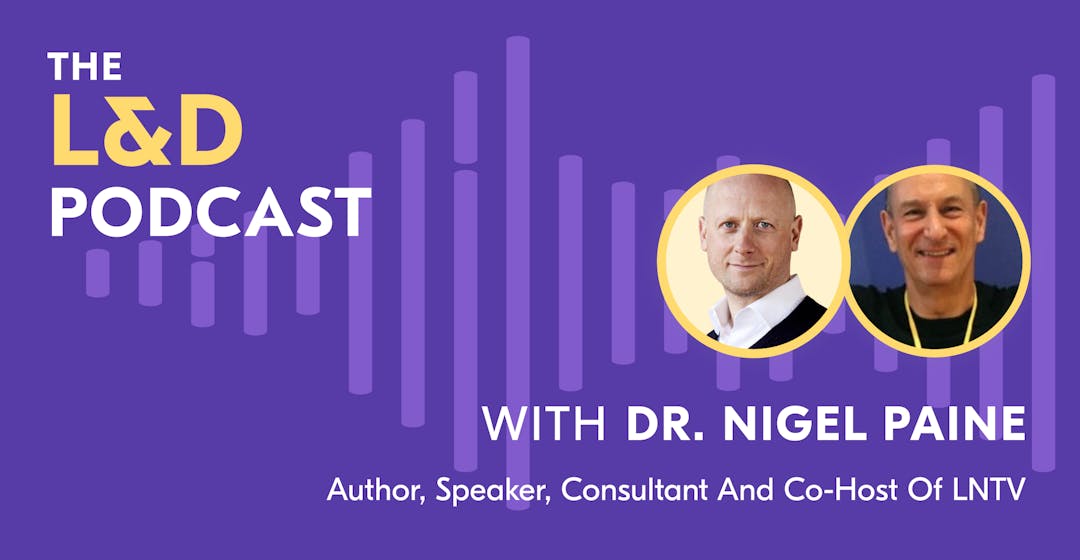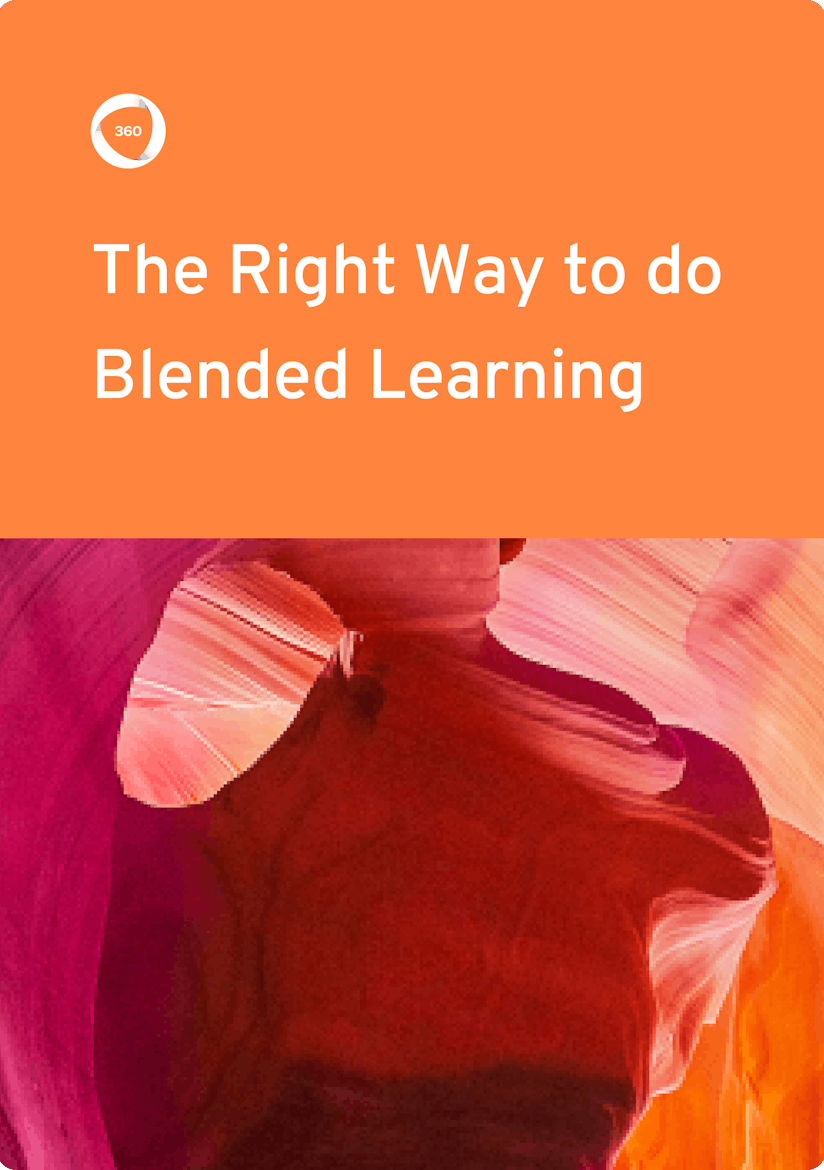
Hybrid Learning: Expert Advice From Nigel Paine on How to Grow Your L&D Practice in 2 Steps
Over the last two years, L&D departments have had to adapt to changing work practices including the shift to hybrid working.
This new working environment has required L&D teams to find novel approaches to learning and as a result, the hybrid learning model has emerged. But is hybrid learning really the answer or are there better ways to make an impact in your organization?
In this podcast recap (check out the full episode here), I speak with Dr. Nigel Paine, Author, speaker, consultant and co-host of LNTV, about his view on the new hybrid learning approach and why evidence-based L&D practice might be the better option to make an organizational difference.
Read on to learn more about Nigel’s methods for implementing evidence-based L&D practice, and how to avoid falling for the latest L&D craze.
Loving what you’re reading? Come and join the L&D Collective for more great learning insights, resources, and events!
Hybrid learning: solution or craze?
The main drawback with a model like hybrid learning, as Nigel explains, is that it's inward-looking.
“When you start talking about models like hybrid learning,” he says, “it’s easy to get swept up in the current craze. We end up riding the bandwagon instead of focusing on the most appropriate thing to do for our organization.”
In Nigel’s experience, models come and go. “What is the difference between hybrid learning and learning? You've got to do learning in the context, in the circumstances: it doesn't need to be labeled a ‘model’ as far as I'm concerned,” he says. “It's basically finding a new way of positioning the same old, same old.”
And that creates the problem. It encourages a weakness in L&D practices, Nigel explains, because we don’t look for evidence or examine what works.
Looking for more tips on how to support learners in a hybrid environment? Check out our free ebook: The Right Way to do Blended Learning

Inside: The fundamental change you must make to your blended learning programs
By providing your contact info, you agree to receive communications from 360Learning. You can opt-out at any time. For details, refer to our Privacy Policy.
Why context is everything
As Nigel explains, organizations today are facing a crucial learning deficit. The solution? Lots of new learning, in different ways, developed in context with learners.
“As the world becomes more uncertain and turbulent, the only way that organizations can deal with that is to increase the ability of people to conquer the complexities and help the organization re-establish itself. We need a lot of learning, and we need to learn in different ways,” he says.
We need people within an organization talking to each other so they can work on a firmer base and know what the organization knows.
“But the last thing I would ever do to anyone in an organization is tell them what they need. I would try to help them work out for themselves the optimum requirement in a particular situation,” Nigel says.
“And for me, increasingly, context is everything. It happens in a real place with real people in real circumstances. And as soon as you say hybrid learning, you are out of context,” he explains.
Identify problems then craft solutions
Research shows that if you have solutions in search of problems, you don't do as well as if you work to understand the problem and then craft a solution.
“I also think it makes L&D departments look foolish when you go into non-L&D meetings and say, ‘So, I think a hybrid model is a solution,” says Nigel. “And people say, ‘What do you mean? Just give us something that works’.”
Research shows that if you have solutions in search of problems, you don't do as well as if you work to understand the problem and then craft a solution.
In other ways, Nigel finds, it stops you from thinking because you come up with the hybrid learning solution and search for the problem to squash in.
“It's the other way around that matters,” he says. “We work to understand the problem and then craft solutions that will solve the problem or at least attack the problem. Therefore, I think it gets in the way and doesn't help.”
Related: 3 Steps to Solving Evergreen Problems: A Framework From Expert Gabe Gloege
Do new models easily sway the L&D profession?
In Nigel’s view, we in L&D can be easily swayed when it comes to new model trends like hybrid learning.
“I've got my obsession with practice at the moment. If everyone in L&D saw themselves as practitioners, and a key part of their role was to enhance their practice, I think that would set them on the right path,” he explains.
For example, if you see a physiotherapist and say your hip is troubling you, they’ll still carry out an examination because it might not be your hip. They will work out the issue, solve it, and keep in touch during your recovery. The physiotherapist is enhancing, in control of, and getting better at their practice.
“I would like to see more L&D people who are in control of their practice and are determined to get better at their practice. And when I say get better at their practice, that isn't working out which bit of software to use, but deeply understanding the problem.”
I would like to see more L&D people who are in control of their practice and are determined to get better at their practice. And when I say get better at their practice, that isn't working out which bit of software to use, but deeply understanding the problem.
“And therefore, you have a different relationship with a supplier. Every profession has suppliers, but you have to get the right relationship. That is, not suppliers who tell you what you need, but what will fit the bill you've already determined,” Nigel says.
Nigel's 2 steps for growing your L&D practice
In Nigel’s experience, you can take two key steps to improve your L&D practice: doing your fieldwork and gathering the evidence.
First up, you need to do your fieldwork.
1. Do your fieldwork
Nigel has identified a significant gap in L&D due to a lack of fieldwork.
“I think fieldwork is a great help. If you go out there, talk to people, and observe what's really going on in the organization, you’ll understand that often, what someone is telling you is the problem isn't actually the problem. It's something completely different,” he says.
“Therefore, you focus on the organization and on solving organizational problems. If some of those are to do with individual competence, systems, or performance, deal with that. But you should always start with what isn’t going right in the organization.”
“Fieldwork is doing your testing and presenting a case to the organization and saying there's a whole case, I can solve this bit, but you have to solve these other bits. We work together on righting this organization, transforming it, or putting it back on track,” Nigel explains.
2. Gather your evidence
Secondly, the only way you can get credibility in demonstrating your case to the organization is to present evidence.
“If you are a finance director, you have an abundance of evidence. You walk in with a big bundle of spreadsheets and say to the stakeholder, ‘Look at this. You see, that's the evidence’,” Nigel explains. “And they say, ‘Wow, I better do something about that’.”
The evidence didn't magic itself in existence. The finance director didn't decide to tackle the problem because someone who knows nothing about finance told them what they thought the problem was–it just doesn't happen like that.
“Whereas in L&D, you go in and say, ‘Oh, you think that's the problem. I'll go away and solve it,” Nigel says. “So, there's this massive competence and credibility gap between a finance person, a marketing person, a salesperson, and an L&D person. They should all be on the same level, operating in the same way.”
In Nigel's experience, this competence and credibility gap is massive when working through capability gaps in organizations finding it hard to adjust to the new world. “You need evidence and clarity of thought,” he says.
Related: A Deep Dive into Conducting a Learner Needs Analysis from A to Z
An evidence-based approach starts with asking why
When establishing a more evidence-based approach, Nigel finds it comes down to one word: why?
As he explains, start conversations by asking what makes you think there’s an issue here and what evidence have you got? Do you think other areas could point to the problem or indicate why this problem occurs? Have you thought about discussing this with X, Y, and Z?
“Those conversations will get you further down the track than saying, ‘Yes, I'll deliver it. When do you need it? Friday? Okay’. And then you’re straight out the door to get a course on X,” explains Nigel.
“We need knowledge of human behavior, motivation, and understanding and not accept the status quo. Of course, it's tough when you've got the force of the organization coming down on you like a ton of bricks, but you can do it,” he says.
If you can design something that makes people’s lives easier, helps them do their job more effectively, and helps them understand the organization more clearly, Nigel finds that they’ll bite your hand off to get at it. But coming in with a hybrid learning solution here doesn’t help you or learners.
Related: Did That Training Really Work? Measuring the Impact of L&D With Kevin M. Yates
How to get started with an evidence-based approach
As Nigel explains, you've got to turn from being an inward-looking huddle to an outward-focused group.
To do that, he emphasizes that you need to do your fieldwork, gather the evidence, and see yourself as an L&D practitioner.
Do your fieldwork: The entire team has to do the fieldwork, and you have to negotiate that with the whole organization. Doing your fieldwork helps you operate with more confidence because you’re offering to work with evidence in your hand.
Gather the evidence: There is research out there. Check out bits of theory that you know about and are valid. This doesn’t mean doing a literature review but being aware of what’s out there and of articles that lack backing evidence.
See yourself as a practitioner: Develop your practice monthly, year on year. If you do your fieldwork, you see yourself as a practitioner, bring evidence to bear, and know that you're part of the bigger organization. You'll also notice that most problems need to be solved together, not in isolation.
Thanks to Nigel for sharing his experience and insights on the hybrid learning model and growing your L&D practice. Keen to learn from more L&D experts? Check out my conversation with Carrie O. Graham on how she uses Adult Learning Theory to ramp up skill development pipelines.
Want more peer insights on transforming workplace learning? Sign up to become a member of the L&D Collective, and check out our other #CLOConnect interviews with top L&D leaders on driving growth and scaling culture through Collaborative Learning. Or you can subscribe (below 👇) to our weekly newsletter to receive our latest posts directly in your inbox.

